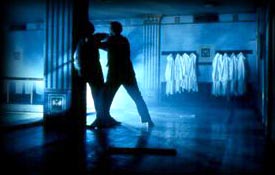Challenge 3
THE THIRTEENTH FLOOR
its relationship to an Evolutionary and Computational Epistemology
Background:
Think about the nature of simulations,
models and representations, how they are stacked one upon the other, and how
they mediate our knowledge of the world. What we think we know about the world
is filtered through many layers: our cultural beliefs and preconceptions, our
thoughts, discourse, language and senses. How might we better come to know the
world by understanding and utilizing the conceptual implications of computation
and evolution? In this challenge I would like you to explore some of the entailments
of adopting an evolutionary and computational epistemology, a new scientific
theory of knowledge.
Formulate your arguments based on your
own knowledge gained outside and inside our class, but I would like you to specifically
address the foundational ideas suggested in our:
- readings:
- Danny Hillis
- Edward Fredkin
- Time Magazine 1950
- Jay Forrester
- Gary William Flake
- Marvin Minsky
- videos:
- Karl Sims' Evolved Virtual Creatures
- Karl Sims' Compilation of Simulations
- Institute for Creative Technologies
- Mission Rehearsal Exercise
- Marvin Minsky: Nara
- TVRO - Amsterdam
- Nightline: Brave New World
- experiences with programming language(s):
- Multi-Agent Applications
- Emergence
- Local versus Global Knowledge and
Action
Focus:
In order to provide you with a focus for
your thinking, I would like you to rent and watch the movie THE THIRTEENTH FLOOR
and critique it from the perspective of an Evolutionary and Computational Epistemology.
You will probably have to watch it more than once. The first time through will
acquaint you with what is going on in the plot. Only on the second viewing are
you likely to notice the subtleties in the acting and directing. I would like
you to analyze and critique one key scene when Douglas Hall and Jane Fuller
meet for the first time. I would also like you to critique and analyze the film
in its entirety. Film-makers as well as social scientists build representations
of the world. What devices did these film-makers use and were their choices
successful? I would suggest that you rent and watch it (101 minutes) before
we view it in class on Wednesday. That way you may have a more meaningful basis
for discussion after class at lunch.
|
|
THE THIRTEENTH FLOOR
Click
on the image or the title to visit the official Sony Web site.
There you will find:
The 3D Virtual World.
The Basement Philosophers Library.
(the library is a little out of date)
|
|
Douglas
Hall
Jane Fuller
Hannon Fuller
Whitney
Detective Larry McBain
|
played
by Craig Bierko
played by Gretchen
Mol
played by Armin Mueller-Stahl
played by Vincent D'Onofrio
played by Dennis Haysbert
|
Please address the following suite of quesitons
in your essay. Please turn it in on paper and on floppy (as a word.doc).
When Douglas Hall meets Jane Fuller
for the first time, in the presence of Detective Larry McBain, there is a short
but enigmatic exchange between them:
Please deconstruct Douglas' and Jane's
emotional reactions on meeting one another for the first time. What are they
thinking and not saying? What is going on unconsciously in their minds? Douglas
is seems sincere. Jane appears to little cagey. What are the multiple or hidden
meanings behind what they each say?
Considering the entire film and story
and what we have come to understand about a computational and evolutionary epistemology:
- What do the references to deja-vu and
memory leaks have to do with the spring on the baseball game being broken?
- How are there differences between the
worlds portrayed?
- How might Hannon Fuller have come to
know the truth in the first place? They never tell us.
- Let's assume, for a moment, that we
have the technology to do what they say they can do in the film. Allowing
the director wide artistic license, are the similarities and differences between
ideas in the story and ideas among researchers in strong Artificial Life?
These ideas revolve around a computational and evolutionary world view and
might include: Are our brains computers? Can computers think? What are the
boundaries? Elaborate...
Have fun with this...
